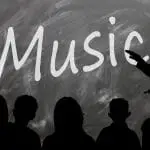From the Bantu tribes to the small villages in Vietnam to the ultra modern cities of America, music reverberates without exception. There are no outer limits to the reach of music and there is no upper or lower age limit to receive and produce music. Babies connect to the emotions of melodies before they understand the simplest words. Music is truly all pervasive. Studies suggest that music is also inherently significant to our evolution as Homo sapiens.
The role of language in helping our race survive is a commonly understood fact. It helped us come together in large numbers; a feat that no other species seems to have accomplished. The ability, to communicate a common cause and bring people together to work towards it helped the Homo sapiens survive. However, it is speculated that music was part of our collective culture way before we managed to develop a language. Music probably brought us together before language did, and continues to do so, when language fails. Why is language such an inherent part of our existence? What makes us so responsive towards music? Studies argue that this might have to do with our neurological set up. But before we go into the details of our tryst with music, we have to define music.
What counts as ‘music?
It is important to distinguish between the production of sounds and the production of music. Most animals seem capable of producing sounds, even voice modulations. However, do they constitute music? How is human music different from those of animals? Different people have defined music based on its function, structure or manner of production. It is often assumed that music is any sound that expresses or conveys an emotion. It is also necessary to highlight the fact not all sounds that express emotions are music. Music has to involve a variations in pitch and maintain a rhythm. This definition narrows down instances of music and the species that are capable of producing music. Not all of our ancestors were capable of carrying a tune or staying on a beat. How do we know this? Fossils tell us what our ancestors were capable of.
Evolutionary evidence for musical abilities
It is a logical assumption that the initial instances of music must have been produced by our own bodies, rather than through instruments. Rhythmic humming or specialised vocal calls must have started our musical journey. However, that puts a lot of our ancestors out of the musical group. We now know that producing music through our vocal apparatus requires several different functions. Respiratory control and advanced motor abilities are just a few of them. These abilities are also very much required for the acquisition of language.
Studies based on the jaw and cranial structures of our ancestors suggest that the Homo ergaster must have been the first in the line to be able to vocalize pitch variations. However, there is not enough muscular support for adequate breath control for producing music as we known it. Homo heidelbergensis had the was slightly more endowed with vocal apparatus but less mentally prepared for musical tasks. Homo neanderthals seem to have had a good enough apparatus, however, fine musical capabilities are usually attributed entirely to the more recent Homo sapiens.
Neurological adaptations for music
The Homo sapiens brain has a few notable differences when compared with that of an ape. One of the main differences is the comparatively smaller visual cortex. While apes have a proportionately large visual cortex, when compared to their brain size, the Homo sapiens seems to have sized down. The temporal lobe, specifically the dorsal side seems to have come into prominence. This area is associated with the production and reception of rhythms and sounds.
Exposure to music has been associated with larger cortical expansions. The cerebral cortex has been a key factor in getting the Homo sapiens here. The expansion of the cerebral cortex, initially gave rise to mammals and eventually to the human race. The development of advanced cognitive abilities is also very much connected to this process of cortical expansion. Interestingly, higher degrees of social connectedness shows higher cortical expansion rates. This is supposed to be because larger groups involved maintaining more connections and keeping track of each relationship. This probably required more mental activity and therefore a larger cerebral cortex. The correlation between cortical expansion and music is because of the fact that societies with higher musical inclinations tend to have stronger and larger networks.
Social functions of Music

Before music became a phenomenon of its own, before entire industries came to be built on its spine, music was likely a functional tool. It must have been a medium of communication among groups of people, between individuals or just tools of expression. The father of the theory of evolution, Charles Darwin also found ‘song’ an interesting peephole into human culture. He surmised that at some point music must have served as a mating call, much like what we see among different species of animals and birds. Darwin was also the first person to draw a connection between music and the human social evolution.
Music is mostly a social phenomenon, guided primarily by the instinct to relate to the people around us. Most cultures around the world have music as an integral part, some indulge in it more than others. We must have had music for longer than we have had language. In fact, Neanderthals are speculated to have been more music oriented than us homo sapiens.
Social adhesive
One of the primary functions of music is as a social glue. The synchrony involved in collective musical activities help people connect and work together. Most pre-industrial workplaces had work songs. Agricultural activities involve workers singing together, even today. The rhythm of these songs are often simple and the actions involved in these jobs are aligned with the rhythm. This makes the work seem effortless are much more efficient. Similarly, children are often encouraged to sing simple tunes in synchrony, which has been known to help them develop social skills. Sports teams often have chants that the teammates do together, to reinforce team spirit.
Initiating newborns into our respective cultures is an important part of what we do as human beings. This is often done through music, since initiation starts way before an infant’s language abilities are formed. There is evidence to suggest that children are receptive to music even before they are receptive to language. Children distinguish between pitches and rhythms and use them in trying to understand the world around them. They have been shown to have specialised responses to different genres of music and different kinds of rhythms. This is also evidenced by the fact that lullabies tend to be structurally similar across cultures and languages. Evidently, music is an extremely potent tool for us to connect to our fellow beings.
All human settlements are known to have had some form of ritualistic practices. They were probably religious, however, the classification of activities as “religious” is often without any specific evidence. All such religions seems to have incorporated music into their rituals. This could be as an easier way of indoctrination into the younger generations. Scriptures are often set to tunes to make it easier for people to remember them.
Universal language
Moreover, different kinds of music indicate our attitudes towards the events of our lives. Plato pointed out that we have common attitudes associated with some basic features of music, across cultures. Minor notes are often associated with sad, gloomy feelings and major notes usually inspire joyful feelings. Similarly, fast tempos are used for celebratory occasions across cultures while slow tempo songs feature in sombre settings. The universality of these features indicate our neurological predispositions.
Interestingly, different cultures have different attitudes towards certain universal events of life. For instance, some cultures understand death as a sad, gloomy affair, and the music reflects the grief of the event. However, some cultures celebrate death, or rather, view death as an opportunity to celebrate the life of the bereaved person. The music played at such a funeral can be outrageous to the other cultures. This also means that music often shapes our realities, pretty much the way languages do.
Conclusion
Music is as much a part of our history as our cognition itself. As a social phenomenon, it is one of the first things we hear as foetuses and the last thing we ‘hear’ as a cultural event. We are literally born into music and we die surrounded by music.
Unsurprisingly, our bodies have also adapted to the huge presence of music in our lives. One theory is that music was a proto-language that used to express primary emotions. This could include mothers playing with their children and using sounds to capture their attention, or trying to attract a mate. This inevitably influenced our neurological systems to accommodate the processing of huge amounts of auditory data. Our physiology also adapted appropriately to facilitate the production of music, which eventually helped with language. What we understand now as music is therefore, reflections of several evolutionary features and cultural exchanges, across a million years.



